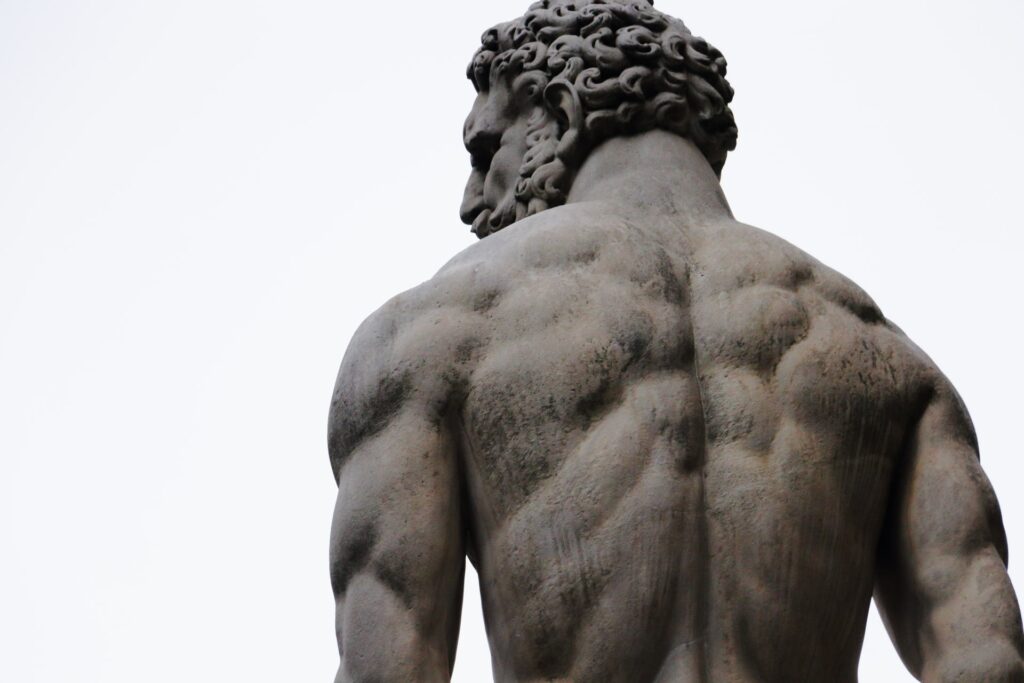Rotator cuff exercises are getting more and more popular in recent times. Athletes often highlight that your shoulder external rotators help you stabilise your bench and prevent shoulder joint injuries. It is extremely hard to overlook that factor if you are a powerlifter and even harder if you’ve been ever introduced to the structural balance principles (originally popularised by Charles Poliquin).
Strong and durable rotator cuff muscles are indeed important but in the presence of this often highlighted fact, it is very easy to overlook other factors. One of these factors is well developed upper back musculature.
Table of Contents
The anatomy and functions of rotator cuff muscles
The rotator cuff muscles are a group of muscles that are located in the shoulder and play a critical role in maintaining shoulder stability and mobility. These muscles consist of four muscles: the supraspinatus, infraspinatus, teres minor, and subscapularis.
The supraspinatus muscle is located on the top of the shoulder blade and is responsible for initiating shoulder abduction, which is the movement of the arm out to the side. This muscle also helps to stabilize the humerus bone in the shoulder joint, which is essential for maintaining proper shoulder alignment.
The infraspinatus muscle is located on the back of the shoulder blade and is responsible for shoulder external rotation, which is the movement of the arm away from the body. This muscle also helps to stabilize the humerus bone in the shoulder joint, which is essential for preventing injury and maintaining proper shoulder function.
The teres minor muscle is located on the lateral aspect of the shoulder blade and is responsible for shoulder external rotation and adduction, which is the movement of the arm toward the body. This muscle also helps to stabilize the shoulder joint and prevent dislocation.
The subscapularis muscle is located on the front of the shoulder blade and is responsible for shoulder internal rotation, which is the movement of the arm toward the body. This muscle also helps to stabilize the humerus bone in the shoulder joint, which is essential for preventing injury and maintaining proper shoulder function.
Collectively, the rotator cuff muscles play a vital role in shoulder function and stability. They work in conjunction with other muscles such as the deltoids and the trapezius to facilitate movements such as shoulder abduction, external rotation, and internal rotation. Additionally, the rotator cuff muscles play a critical role in maintaining proper shoulder alignment, which is essential for preventing injuries such as rotator cuff tears and shoulder impingement.
To develop strong and functional rotator cuff muscles, it’s essential to incorporate exercises such as external and internal rotations, lateral raises, and face pulls into your training program. These exercises target the different regions of the rotator cuff muscles and can help to improve strength, stability, and mobility in the shoulder joint. It’s important to focus on proper form and technique when performing these exercises to prevent injury and maximize results.
Gain an unfair advantage over your opponents
A strong upper back is the foundation for a big bench. It helps you stabilise the weight by pressing your scapulae into the bench pad and acts as your fundaments. Having a strong upper back can help you win over your rivals by allowing you to lay a strong foundation to press from.
Rear delts along with traps and rhomboids are responsible for retracting your shoulder blades (pushing them back). This movement enables you to push your chest out, shorten the range of motion on the bench, activate your pectoral muscles more, stabilises you on the bench and gives your central nervous system the green light to engage the pushing muscles. Without strong antagonists (the opposing muscles), your CNS will not allow you to utilise your whole strength. The force production will be hindered as it is a safety mechanism to prevent joint dislocation, muscle tears and other injuries that can occur as a result of not being structurally balanced.
The central nervous system acts as a commander. It governs the function of your muscles and coordinates them together. If it realises that some links of the chain are too weak, the force production within the entire chain is instantly diminished. If you want to prevent that, ensure you have well developed stabilisers and antagonist muscles.
6 exercises that will help you develop your upper back
The article wouldn’t be complete without a list of useful exercises that will get you to your destination. The movements listed below will help you build a bulletproof upper back that will support your bench and make you look bold and swole:
- Chest Supported Rear Delt Rows
- Rear Delt Landmine Rows
- Throat Pulls
- Side-Lying Incline Bench DB Powell Raise
- Single Armed Reverse Pec Deck Flyes
- Chest Supported Horizontal Shrugs (Saggital Plane)
Remember that all of these exercises are to be executed as accessory work! Do not expect your bench to go up by 20kg just because you started doing Rear Delt Flyes! They are meant to strengthen your upper back to increase your stability on the bench and act as a foundation to build upon.
Upper back pain
Weak rear delts, rhomboid and traps can also be the cause of upper back pain. If you bench press a lot and complain about upper back pain, weak upper muscles might be the culprit. In this case, before you begin adding more weight on the bench, reorganise your training and add some exercises that target your back. This way, you can even out your strength ratios (correct your structural balance) and minimise upper back pain.
Upper back stretches
Upper back stretches can help you keep your mobility as you’re increasing your muscle mass. They are also beneficial for recovery, because loosening up tight tissue improves blood flow to the area and blood carries oxygen along with nutrients. Increased nutrient delivery to the muscle tissue improves recovery and increases muscle growth. Adding upper back stretches at the end of your workout can help you get stronger, bigger and recover faster.
How to train your upper back muscles?
You need strength to be able to forcefully retract your scapulae and bring your shoulders backwards and strength-endurance to keep them retracted for long enough. These two training parameters are essential if you desire to be able to move heavy weights and remain injury-free. In order to develop these parameters, you will have to use both, high and low rep ranges.
If you’re already rowing heavy weights (if not, then you should be!), you are probably giving your rear delts enough stimulus (assuming you are a beginner) to get stronger but bear in mind that if you want to become an elite lifter, it is not enough. Also, apart from strength, you will need strength-endurance so you can maintain the force production for long enough to complete your bench press set. Finally, you will need to be able to repeat this process for all of your bench press sets which means you will need enough work-capacity to last throughout the whole workout.
If you are to develop all three of these abilities (the ability to produce more force, the ability to sustain force production during a set and the ability to be able to perform multiple sets), you will have to use enough weight, for enough repetitions and for enough sets. You first build strength by performing a couple of heavy sets and then either move on to another exercise and execute it for a higher rep range or strip some of the resistance off and aim for the same (that is more reps with less weight). Make sure though that you train your rear delts, rhomboids and trap after your heavy deadlifts and rows.
Covering mentioned above principles will allow you to develop one hell of a strong and durable upper back that will give you an advantage over your competitors.




